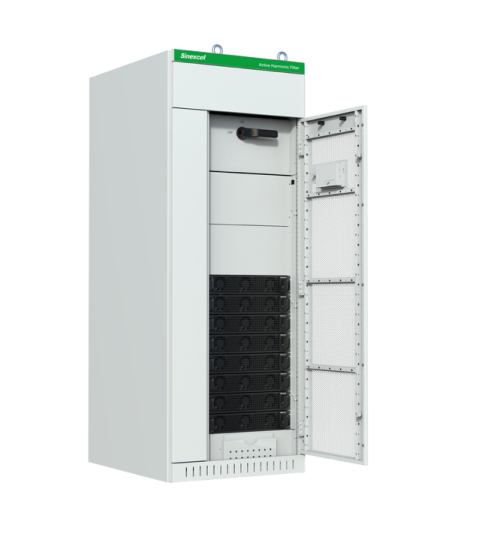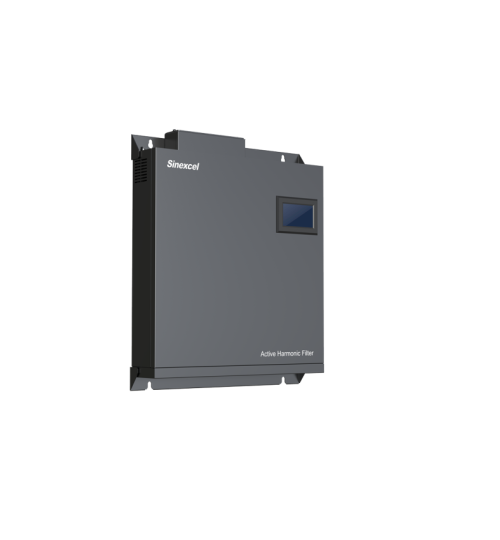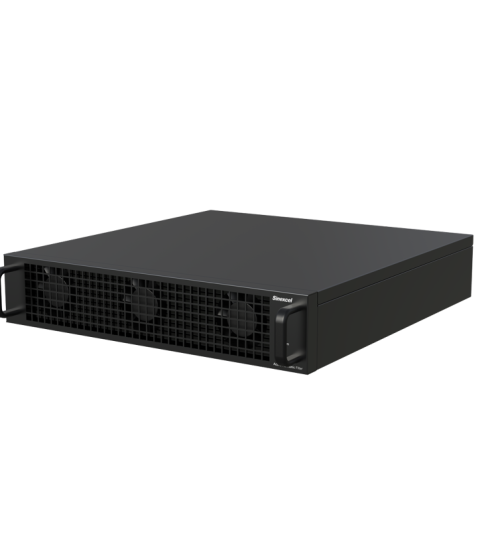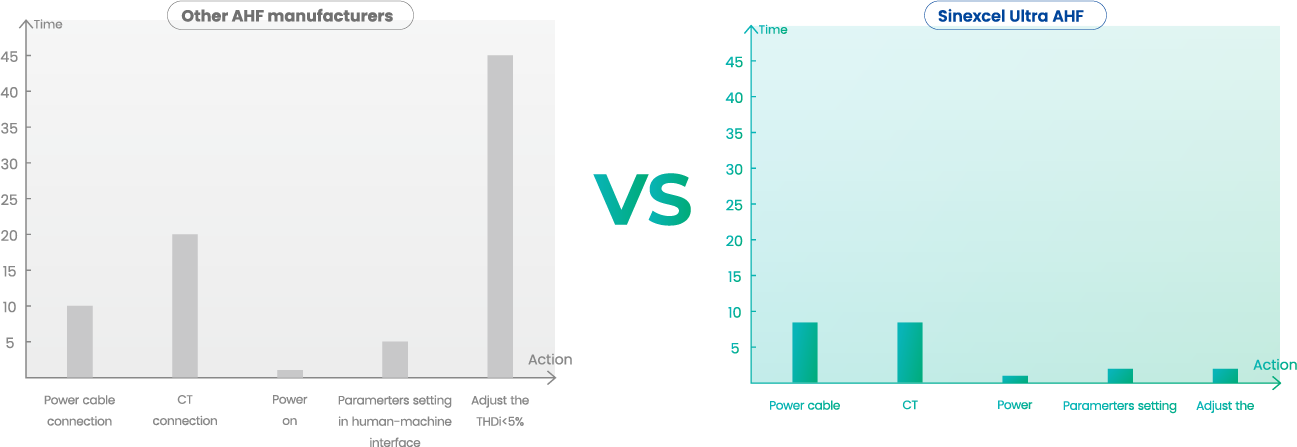AHF ACTIVE HARMONIC FILTER
Our products



Introduction
Active harmonic filters (AHF) are advanced power quality devices designed to eliminate harmonic distortions in electrical systems. Harmonics are unwanted frequencies that distort the ideal sinusoidal waveform of electrical current, often caused by non-linear loads such as variable frequency drives, rectifiers, and other electronic devices. AHFs actively monitor and correct these distortions by injecting compensating currents that counteract the harmonics, thereby improving power quality.
Advantages and main features
Peak efficiency >99% Automatic fine tuning of THDi <5%

- Evolution of formidable performance through SiC MOSFET technology
- Ultra high efficiency 99%
- Huge 97% harmonic compensation
- Small dimensions with huge capacity ≥ 18kg
- Superlative advances in applications
- Supersonic resonance
- THDu Mitigation
- Automatic fine tuning
- Protective sealing
- Easy maintenance
- Flexible cabinet with top ventilation
ULTRA HIGH EFFICIENCY
Performance advancement thanks to SiC technology
Silicon carbide (SiC) MOSFETs achieve ultra-high efficiency primarily due to their wide bandgap, which leads to lower on-state resistance (Rds(on)), faster switching speeds, and reduced switching losses. These properties enable SiC MOSFETs to operate at higher frequencies and temperatures with improved overall performance, resulting in more efficient power conversion systems.
What benefit will the user get from ultra-high efficiency of 99%?
Savings on electricity bills, higher return on investment.
EXTREMELY HIGH HARMONIC COMPENSATION
RATE Performance gains thanks to SiC technology
SiC technology offers much higher switching frequency (average 40KHz and maximum up to 95KHz) than our AHF. With the high switching frequency and exclusive algorithm design, our AHF achieves the huge harmonic compensation rate.
> 97% harmonic compensation (harmonics of order 2 to 13)
> 95% High harmonic compensation (harmonics of order 31 to 51)
> 95% compensation for even harmonics
AUTOMATIC FINE TUNING
Momentous advancement enabled by SiC MOSFET technology
Our AHF updates the software algorithm and when the TCs are on the source side, it sets up a closed loop. The special algorithm can automatically identify and correct the compensation output result and process without manual adjustment.
Automatic fine tuning makes adjustments to obtain THDi <5%, so the adjustment process will be completed in just a few minutes.
Easy software operation and simple hardware installation. Only power cables and a set of CTs are required to configure the AHF. The automatic adjustment function achieves excellent and intelligent compensation effects, providing users with a simple and efficient commissioning experience.

Resonance suppression
Unique intelligent Fourier technology
In the process of solving power quality problems, the direction that the industry has been focusing on is how to solve resonance; when the system resonates, it will generate a voltage several times higher than that of the power supply. This voltage will be applied to capacitors, transformers, circuit breakers and other equipment in the circuit, even causing insulation damage to high-voltage electrical equipment.
Our AHF design suppresses resonance by using unique intelligent Fast Fourier technology and has been an industry leader in resonance suppression technology. This technology ensures the normal and stable operation of the system and prevents harm from resonance to the user.

After several years of persistent research and development, our technology partner’s R&D team launched the resonance algorithm 2.0. Based on the suppression of resonance, it ushered in a new era by achieving the requirement of THDi<5% through perfect sine waves to achieve excellent quality in users’ networks.
THDu Mitigation
Another significant advance for energy efficiency
Extreme voltage distortion can cause multiple zero crossings of the voltage waveform. For equipment where proper sequence of operations depends on a zero crossing for synchronization, voltage distortion can cause malfunctions. Additionally, fifth harmonic voltage distortion can cause serious problems in three-phase motors.
Operating principle
It filters harmonic currents with an operating principle based on “noise cancellation”. The filter measures the real harmonic contamination [1] and injects a countercurrent [2] (up to order 50) that has a shape such that the current seen from the power supply read point of view [3] becomes sinusoidal again.
AHFs allow simultaneous use of their ability to compensate reactive power (both inductive and capacitive) of fundamental frequency and higher order harmonics, making it universally applicable.

Applications
- Industrial Plants
- Heavy Industries: Steel mills, aluminum smelters and chemical plants.
- Manufacturing: Semiconductor manufacturing, automobile production, and textile factories.
- Benefits: Reduces harmonic distortion, protects sensitive equipment and improves overall efficiency.
- Commercial buildings
- Office Complexes: Maintains the quality of electrical power for office equipment and computer networks.
- Shopping Centers: Ensures stable operation of lighting, air conditioning systems and electronic devices.
- Benefits: Prevents equipment malfunction, reduces energy consumption, improves energy quality.
- Renewable energy systems
- Wind Farms: Compensates for harmonics generated by wind turbines.
- Solar Power Plants: Mitigates harmonic distortions from inverters and power electronics.
- Benefits: Improves power quality, supports grid stability and reduces energy losses.
- Public services and energy distribution
- Substations: Provides harmonic mitigation and reactive power support.
- Distribution Networks: Improves energy quality for end consumers.
- Benefits: Reduces transmission losses, improves grid reliability and supports the integration of renewable energy.
- Data centers
- Server Rooms: Protects servers and data storage devices from harmonic distortions.
- Network Operations Centers: Ensure reliable operation of network equipment.
- Benefits: Improves power quality, prevents data loss, and improves system uptime.
- Sanitary facilities
- Hospitals: Maintains power quality for critical medical equipment and systems.
- Diagnostic Laboratories: Protects sensitive diagnostic devices from harmonic distortions.
- Benefits: Ensures reliable operation of medical equipment, reduces energy costs and improves power quality.
Benefits
AHFs play a crucial role in maintaining power quality, protecting electrical equipment, and improving the overall efficiency and reliability of electrical systems in various applications and industries.
- Energy saving
- Reduces energy losses associated with harmonic distortions.
- Improves overall electrical system efficiency, leading to lower energy costs.
- Improved power quality
- Reduces harmonic distortions, resulting in a cleaner, more stable power supply.
- Improves overall system performance and efficiency.
- Improved equipment lifespan
- Minimizes overheating and stress on electrical equipment caused by harmonics.
- Reduces the risk of equipment failure and extends operational life.
- Compliance with Standards
- Ensures compliance with power quality standards and regulations (e.g. IEEE 519, IEC 61000).
- Avoid penalties and ensure compliance with industry standards.
- Versatility and scalability
- Modular design allows for easy expansion and adaptation to changing power demands.
- Suitable for a wide range of applications from low voltage to high voltage systems.
- Improved system reliability
- Protects sensitive equipment and critical processes from harmonic-related interruptions.
- Improves the reliability and stability of the overall power system.
- Support for the integration of renewable energies
- Mitigates harmonics from renewable energy sources, facilitating their integration into the grid.
- Improves the stability and reliability of renewable energy systems.
- Environmental benefits
- Reduce energy waste and lower your carbon footprint.
- Promotes the use of clean and efficient energy technologies.
